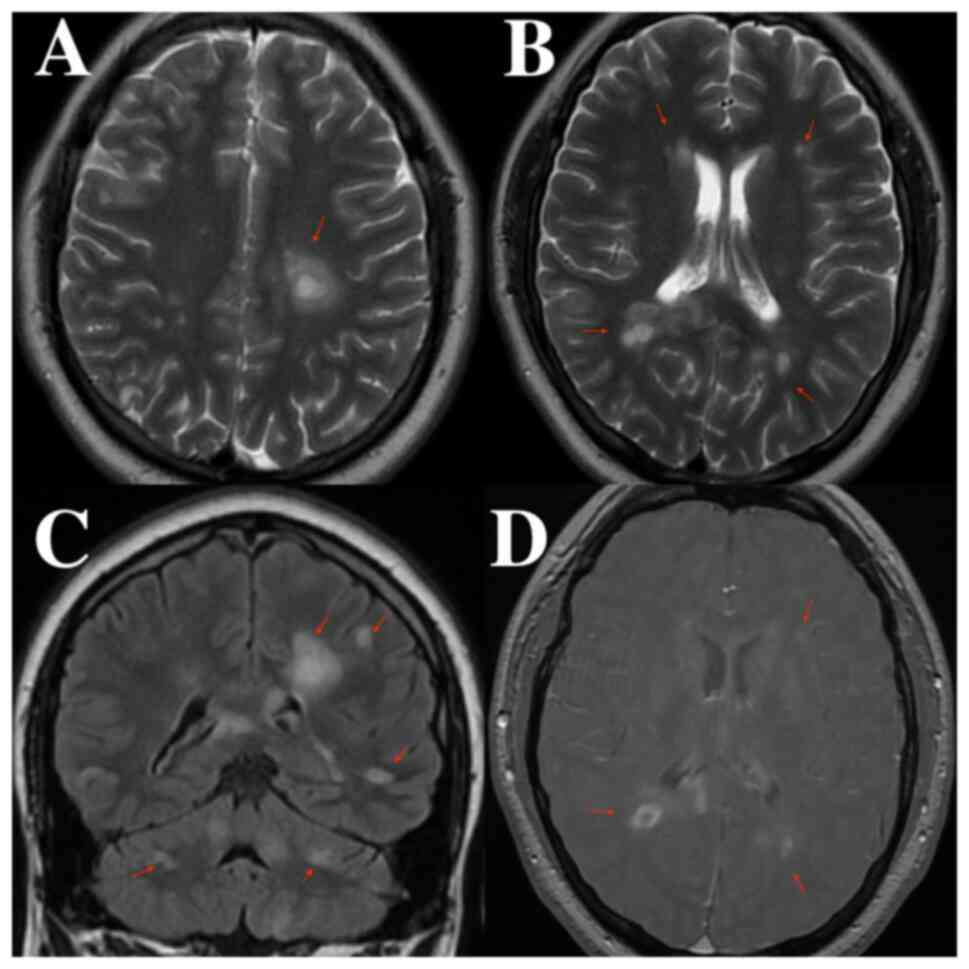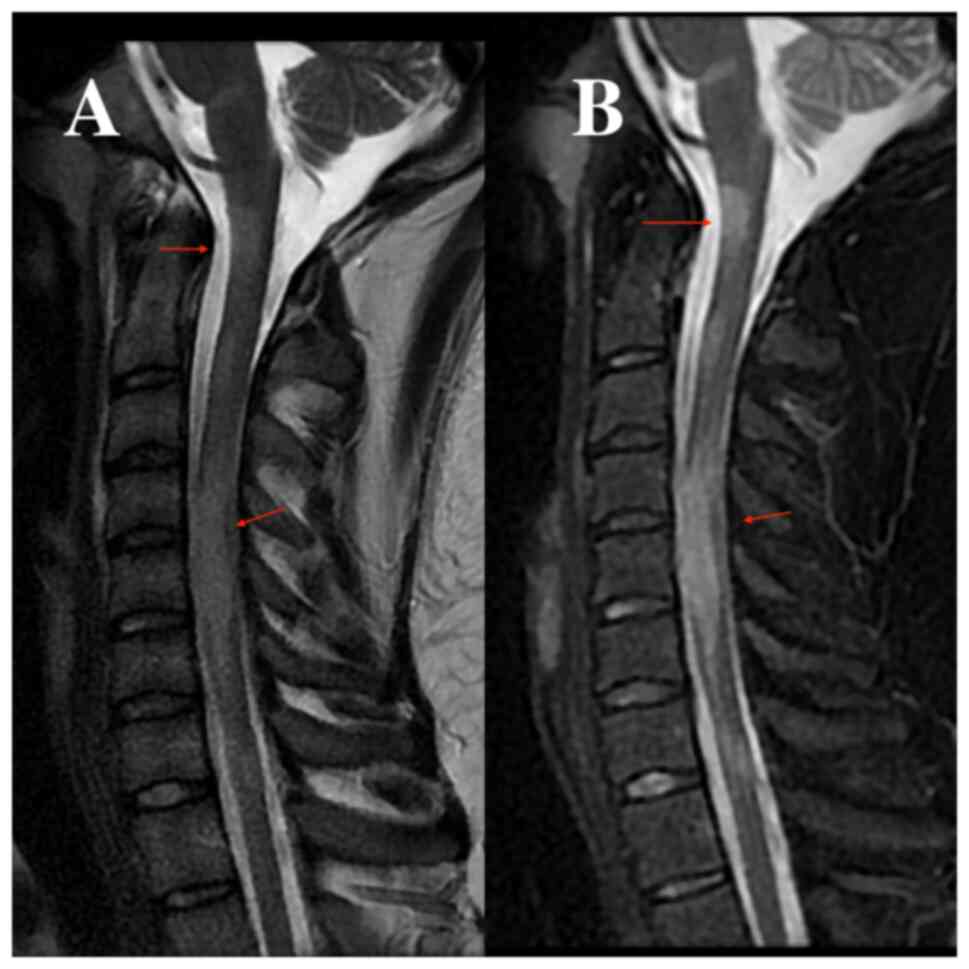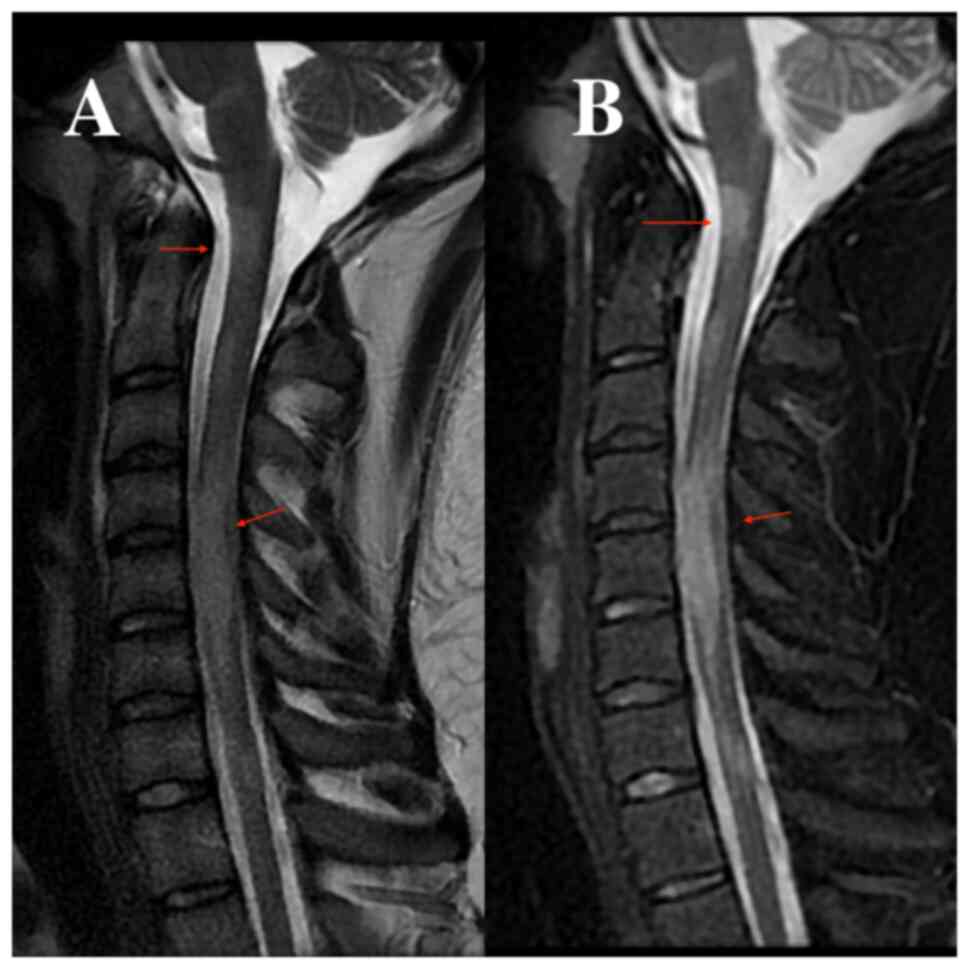Acute disseminated encephalomyelitis in a young patient: A case report
- Authors:
- Published online on: June 17, 2024 https://doi.org/10.3892/etm.2024.12612
- Article Number: 323
-
Copyright: © Codreanu-Balaban et al. This is an open access article distributed under the terms of Creative Commons Attribution License.
Abstract
Introduction
ADEM, known as acute disseminated encephalomyelitis, is an inflammatory demyelinating disorder affecting the central nervous system. This autoimmune disorder predominantly manifests in pediatric and adolescent populations, frequently as a consequence of an infection or immunization (1). ADEM is a rare disease affecting the central nervous system, characterized by an inflammatory response in the brain and spinal cord. It is an acute condition that tends to proceed rapidly (1,2). It is usually monophasic, but some patients may have either recurrences or an ADEM-like presentation as the first attack of a chronic demyelinating disease such as multiple sclerosis (MS) or neuromyelitis optica (2). The wide range of clinical manifestations and progression of ADEM poses difficulties in determining the optimal therapy strategy for each patient. The present study addresses both the potential consequences that may occur with the progression of the disease and emphasizes the beneficial effects of targeted and symptomatic therapy.
The present paper provides an overview of the clinical symptoms, diagnostic methods and treatment options for ADEM. It highlights the effectiveness of intravenous methylprednisolone and immunoglobulin in improving the condition. The paper specifically emphasizes the significance of neurological symptoms and the need to correlate them with biological and imaging results.
Case report
A 19-year-old male, without any previous medical conditions, arrived at the Neurology Clinic of ‘Sf. Ap Andrei’ Emergency County Clinical Hospital (Constanta, Romania) with a sudden onset of speech difficulties, motor impairment in the right arm and paresthesia on the right side of the body. The patient was admitted to the ‘Sf. Ap Andrei’ Emergency County Clinical Hospital in Constanta, Romania, in October 2023 and was discharged following a 19-day hospitalization period.
On admission, neurological examination indicated that the patient was conscious and alert, experienced difficulties mobilizing the right limbs during tests for paresis tests and displayed signs of expressive aphasia. The native computed tomography (CT) scan of the brain revealed a hypodense area in the left corona radiata, but the blood tests showed normal results.
At 2 days after admission, the patient underwent a brain and cervical spine MRI with and without a gadolinium-based contrast substance. The results indicated demyelinating lesions, intracerebral, both infratentorial and supratentorial, cervical and dorsal spinal cord, some of them metabolically active, suggestive for the diagnosis of multiple sclerosis (Fig. 1, Fig. 2 and Fig. 3). On day 5 after admission, the neurologist decided to perform the following tests: MOG antibody, anti-aquaporin 4 antibody, HIV 1+2, VDRL, anti-Borellia bugdoferi antibody, anti-toxoplasma antibody, anti-cytomegalovirus antibody, anti-double-stranded DNA antibodies and extended ANA blot profile serum (Table I). All test results were negative.
Based on the aforementioned findings, the treatment commenced with methylprednisolone therapy at a dosage of 500 mg administered twice daily for a duration of 5 days. Following a 6-day period, a lumbar puncture was conducted. Macroscopically, the cerebrospinal fluid (CSF) exhibited minor hemorrhaging in the first sample tube, whereas the second sample tube appeared transparent and clear. In the complete CSF examination, albuminorachia, glycorrhachia and a total of 66 elements were identified. Positive results were obtained while testing for oligoclonal bands in the cerebrospinal fluid (Table II).
Based on the aforementioned investigations, there was a suspicion of acute disseminated encephalitis. Subsequent evaluations and discussions were conducted in accordance with this. Furthermore, a 5-day prescription of human immunoglobulin therapy was commenced. The neurological condition of the patient demonstrated a progressive improvement from day 5 until the patient was discharged.
The infectious disease specialist recommended IgM for Epstein-Barr virus, including a repeat lumbar puncture to extract cerebrospinal fluid for HIV 1+2 testing, IgM for West Nile virus and Koch's bacillus from cerebrospinal fluid (Table II). The results of all mentioned investigations were negative.
Following a 19-day hospitalization, the patient's health state showed improvement, leading to his subsequent discharge. The neurological examination revealed that the patient was conscious, temporally and spatially oriented, without neck stiffness, normal oculomotor function, denies diplopia, no nystagmus, symmetrical facial expression, normal speech, no swallowing difficulties, no motor deficits, hypoesthesia in the right limbs, ataxia in the right upper limb, bilateral vibratory hypoesthesia in the lower limbs (4/8), and in the upper limbs (6/8) bilaterally. Ataxic gait possibly without support, bilateral Babinski sign and non-systematized positive Romberg sign.
Discussion
Autoimmune demyelinating disorders such as ADEM can pose a significant challenge in differentiating it from multiple sclerosis, leading to delays in achieving a timely and precise diagnosis (3). MRI is currently the most valuable tool in diagnosis and differential diagnosis. However, complex radiological findings can overlap, leading to misinterpretation, confusion or misdiagnosis (4,5).
The present patient represented a challenge in both diagnosis and treatment, primarily because of the diversity of possible differential diagnosis. In the case of this 19-year-old male patient, the main focus of the differential diagnosis was primarily between acute disseminated encephalitis and multiple sclerosis.
In order to support the diagnosis of multiple sclerosis, a series of tests were conducted, encompassing MOG antibody, anti-aquaporin 4 antibody, HIV 1+2, VDRL, anti-Borellia burgdorferi antibody, anti-toxoplasma antibody, anti-cytomegalovirus antibody, anti-double-stranded DNA antibodies and extended ANA blot profile serum testing. However, all findings has negative results. Lumbar puncture was performed. In the complete CSF examination, albuminorachia, glycorrhachia and a total of 66 elements were identified. Oligoclonal bands were also tested in the cerebrospinal fluid with positive results. They were suggestive for identifying the autoimmune mechanism of the diagnosis. At the time of admission, patient assessments included determining any recent exposure to COVID-19 and the patient's vaccination status against SARS-CoV-2 infection. The pandemic that resulted from the spread of SARS-CoV-2 viral infections has affected the population worldwide but has characteristically shown a preponderance for affecting adults (6,7).
In the case of the presented patient, he had not been vaccinated during the pandemic and had not recently experienced symptoms that would raise suspicion of SARS-CoV-2 infection. The brain and cervical spine MRI, performed native and with gadolinium-based contrast substance, indicated the presence of demyelinating lesions. These lesions were observed intracerebrally, encompassing both infratentorial and supratentorial regions, as well as in the cervical and dorsal spinal cord.
The differential diagnosis also considered limbic encephalitis; however, the distribution of the lesions on the MRI did not align. The typical involvement sites in limbic encephalitis are the mesial temporal lobes and limbic systems, usually characterized by cortical thickening and increased T2/FLAIR signal intensity in these regions (5). Given all the evidence and a careful differential diagnosis, the final diagnosis was acute disseminated encephalomyelitis.
We want to underline the importance of adding more identification points between ADEM and multiple sclerosis, highlighting that the use of cerebral MRI images and blood test results is crucial for differentiation and accurate diagnosis of these conditions. These additional details are essential to ensure precise assessments and to avoid confusion between the two medical conditions.
Neurological diseases, particularly those associated with demyelination and inflammation, pose substantial challenges in terms of diagnosis and subsequent management (8). These diseases can present with a wide range of symptoms, which can often overlap with other conditions, making accurate diagnosis difficult (9). Additionally, the progression of these diseases can vary widely from person to person, further complicating treatment plans. Research into the underlying causes of neurological diseases, as well as potential new treatments, is ongoing (10). Advances in genetic testing and imaging techniques continue to improve our understanding of these conditions and may lead to better diagnostic tools and targeted therapies in the future (9,10). Accurate diagnosis plays a pivotal role in guiding therapeutic decisions, facilitating disease monitoring and optimizing patient outcomes (11). However, due to the intricate nature of these disorders, identifying the correct diagnosis can be a daunting task for healthcare professionals. The present study underscores the significance of precise diagnosis in demyelinating and inflammatory diseases, the complexities involved in their identification and the implications of misdiagnosis (11-13).
In conclusion, the case discussed in the current paper effectively illustrated the obstacles that must be addressed in order to establish a precise diagnosis. The wide array of possible diagnoses presented a substantial difficulty in assessing the clinical and radiological presentation of our patient. Timely diagnosis is crucial in commencing suitable therapeutic interventions, which in turn can enhance prognosis results for patients with encephalomyelitis. Yet, the intricate relationship between ADEM and MS presents difficulty in establishing definitive links and comprehending the underlying mechanisms. Ongoing research is being conducted to understand the complex relationship between these disorders and to discover diagnostic markers that might assist in differentiating between them. The progress made in comprehending the connections between ADEM and MS shows potential for developing improved diagnostic tools and adjusting therapy approaches to provide better care for patients.
Acknowledgements
Not applicable.
Funding
Funding: No funding was received.
Availability of data and materials
The data generated in the present study are not publicly available as the data were obtained from Constanta County Emergency Clinical Hospital and, therefore, third-party data restrictions apply. However, the data may be requested from the corresponding authors with the permission of the Institutional Ethics Committee of Clinical Studies of the Constanta County Emergency Clinical Hospital.
Authors' contributions
RACB, AZS and MLF conceptualized the study. DM, SDA, RAB, RB, AEG, DCJ and CEF designed the methodology. RAB and RB were responsible for the imaging software and the interpretation of the figures. RACB, AZS, RAB, RB, AEG, DCJ, CEF and MLF validated the diagnosis and treatment plan through appropriate investigative methods. DMV and CRT formally analyzed the data. RACB, AZS and MLF conducted a thorough literature review to gather information from reliable sources. RACB, AZS and MLF provided the informational resources for the conceptual data of the article. RACB, AZS and MLF curated the data and obtained the medical images. AEG, DCJ and CEF wrote and prepared the original draft. RACB, AZS and MLF wrote, reviewed and edited the paper, provided and edited the imaging data in the manuscript, supervised the study, were project administrators and acquired funding. RACB, AZS, MLF, DM, SDA, RAB, RB, AEG, DCJ and CEF confirm the authenticity of all the raw data. All authors have read and approved the final version of the manuscript.
Ethics approval and consent to participate
The study was conducted in accordance with the Declaration of Helsinki, and approved by the Ethics Committee of ‘Sf. Ap. Andrei’ Emergency County Clinical Hospital (approval no. 1/11.01.2024).
Patient consent for publication
Written informed consent has been obtained from the patient to publish this paper.
Competing interests
The authors declare that they have no competing interests.
References
|
Carlisi E, Pavese C, Mandrini S, Carenzio G and Dalla Toffola E: Early rehabilitative treatment for pediatric acute disseminated encephalomyelitis: Case report. Eur J Phys Rehabil Med. 51:341–343. 2015.PubMed/NCBI | |
|
Paolilo RB, Deiva K, Neuteboom R, Rostásy K and Lim M: Acute disseminated encephalomyelitis: Current perspectives. Children (Basel). 7(210)2020.PubMed/NCBI View Article : Google Scholar | |
|
Eckstein C, Saidha S and Levy M: A differential diagnosis of central nervous system demyelination: Beyond multiple sclerosis. J Neurol. 259:801–816. 2012.PubMed/NCBI View Article : Google Scholar | |
|
Wildner P, Stasiołek M and Matysiak M: Differential diagnosis of multiple sclerosis and other inflammatory CNS diseases. Mult Scler Relat Disord. 37(101452)2020.PubMed/NCBI View Article : Google Scholar | |
|
Tüzün E and Dalmau J: Limbic encephalitis and variants: Classification, diagnosis and treatment. Neurologist. 13:261–271. 2007.PubMed/NCBI View Article : Google Scholar | |
|
Mihai CM, Chisnoiu T, Cambrea CS, Frecus CE, Mihai L, Balasa AL, Stroe AZ, Gogu AE and Docu Axelerad A: Neurological manifestations found in children with multisystem inflammatory syndrome. Exp Ther Med. 23(261)2022.PubMed/NCBI View Article : Google Scholar | |
|
Sirbu CA, Dantes E, Plesa CF, Docu Axelerad A and Ghinescu MC: Active pulmonary tuberculosis triggered by interferon beta-1b therapy of multiple sclerosis: Four case reports and a literature review. Medicina (Kaunas). 56(202)2020.PubMed/NCBI View Article : Google Scholar | |
|
Pirko I and Noseworthy JH: Chapter 48 - Demyelinating Disorders of the Central Nervous System. In: Textbook of Clinical Neurology. 3rd edition. Elsevier, pp1103-1133, 2007. | |
|
Tillema JM and Pirko I: Neuroradiological evaluation of demyelinating disease. Ther Adv Neurol Disord. 6:249–268. 2013.PubMed/NCBI View Article : Google Scholar | |
|
Heath F, Hurley SA, Johansen-Berg H and Sampaio-Baptista C: Advances in noninvasive myelin imaging. Dev Neurobiol. 78:136–151. 2018.PubMed/NCBI View Article : Google Scholar | |
|
Hancu A, Mihai MC and Axelerad AD: Wilson's disease: A challenging diagnosis. Clinical manifestations and diagnostic procedures in 12 patients. Rev Med Chir Soc Med Nat Iasi. 115:58–63. 2011.PubMed/NCBI | |
|
Docu Axelerad A, Stroe AZ, Arghir OC, Docu Axelerad D and Gogu AE: Respiratory dysfunctions in Parkinson's disease patients. Brain Sci. 11(595)2021.PubMed/NCBI View Article : Google Scholar | |
|
Gogu AE, Motoc AG, Stroe AZ, Docu Axelerad A, Docu Axelerad D, Petrica L and Jianu DC: Plasminogen activator inhibitor-1 (PAI-1) gene polymorphisms associated with cardiovascular risk factors involved in cerebral venous sinus thrombosis. Metabolites. 11(266)2021.PubMed/NCBI View Article : Google Scholar | |
|
Budisteanu M, Andrei E, Linca F, Hulea DS, Velicu AC, Mihailescu I, Riga S, Arghir A, Papuc SM, Sirbu CA, et al: Predictive factors in early onset schizophrenia. Exp Ther Med. 20(210)2020.PubMed/NCBI View Article : Google Scholar |












